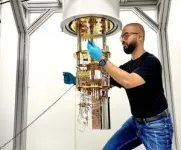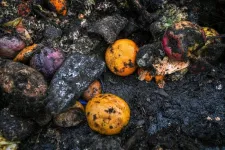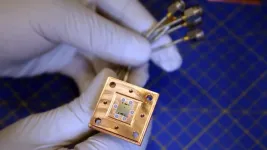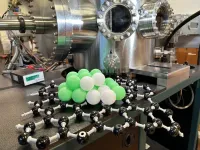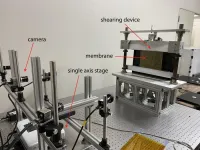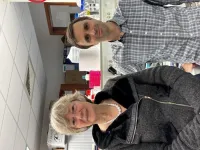(Press-News.org) If you’d like to solve a math problem on a good old-fashioned chalkboard, you want the board clean and free of any previous markings so that you have space to work. Quantum computers have a similar need for a clean workspace, and a team including scientists at the National Institute of Standards and Technology (NIST) has found an innovative and effective way to create and maintain it.
The research effort, a collaboration with physicists at Sweden’s Chalmers University of Technology, could address one of the main issues confronting quantum computer designers: the need to keep the bits in a superconducting quantum processor free of errors and ready to perform calculations whenever necessary. These “qubits” are notoriously sensitive to heat and radiation, which can spoil their calculations just as stray chalk marks might make the numeral 1 look like a 7.
Erasing these qubits after a calculation involves cooling them to a fraction of a degree above absolute zero and then keeping them there. The team’s method is not only more effective than other state-of-the-art methods for erasing the qubit chalkboard because of the lower temperatures it achieves, but it also achieves them in a novel way — powering the eraser using heat flowing between two parts of the refrigerator that keeps the computer cold. This approach could prove itself useful in other ways.
“The technique in this paper could benefit quantum computers,” said the team’s Nicole Yunger Halpern, a physicist at NIST and the University of Maryland’s Joint Center for Quantum Information and Computer Science (QuICS). “It could address one of the problems in quantum computer design, and it also shows that we can siphon heat from one part of the computer’s refrigerator and convert the heat into work. It could introduce technological capabilities we haven’t even thought of yet.”
The team’s proof-of-principle demonstration of the method appears [Jan. 9, 2025] in the journal Nature Physics.
Although quantum computers are far from reaching maturity, they remain the object of intense research because they offer the potential to perform certain tasks that conventional computers cannot do easily, including simulating complex molecular structures that are important in drug design. These projected capabilities derive from a difference between qubits and the bits in a conventional computer: While a conventional bit can exist in two states, 1 or 0, a qubit can have both values simultaneously, nominally allowing a quantum computer to sift through vast numbers of potential solutions at once.
A promising way to make qubits is to build them from superconducting circuits, which are the type the team used in its study. Superconducting qubits bring advantages including tunability: Experimentalists can change the properties of the qubits as desired. However, qubits — even those that superconduct — can develop errors very quickly, which can ruin calculations.
Erasing a superconducting qubit means resetting it to its lowest energy state, which has proved to be tricky. An effective way to reset the qubit would be to make it as cold as possible, down in the tens of millikelvins (mK), or thousandths of a degree above absolute zero. Until now, the best reset methods have brought qubits to a range of 40-49 mK. While those numbers might sound good, they aren’t good enough, said co-author and quantum physicist Aamir Ali of Chalmers University of Technology, where the team’s experimental work was conducted, supervised by principal investigator Simone Gasparinetti.
“In a quantum computer, initial errors can compound as the calculation proceeds,” Ali said. “The more you can get rid of them at the outset, the more effort you will save later.”
The team’s method can cool the qubit to 22 mK. The improvement would erase the board more completely, reducing the likelihood of initial errors causing trouble down the line.
“If you didn’t cool the qubit to that low a temperature, you wouldn’t be able to erase the board as thoroughly,” Yunger Halpern said.
The team has achieved these performance numbers using a “quantum refrigeration” technique that has never been harnessed in a practical machine before. A refrigerator cools objects by using some sort of energy to draw heat away from the fridge’s interior. In a conventional kitchen fridge, the energy source is electricity, but the quantum refrigerator would use heat from elsewhere in the computer to do the job.
The team’s fridge uses two other quantum bits as its components. One qubit, which would be connected to a warmer part of the computer, would serve as the energy supply. The second quantum bit would serve as a heat sink into which the computational qubit’s undesired extra heat could flow. In an actual quantum computer, if the computational qubit — the chalkboard — got too warm, the fridge’s first qubit would pump heat from the computational qubit into the heat sink, which would carry the heat away, returning the computational qubit to nearly its ground state and erasing the board.
The process works autonomously, requiring minimal external control or additional resources to maintain the computational qubit’s ability to calculate.
“We think this approach will pave the way for more reliable quantum computing,” Ali said. “It’s hard to manage errors in quantum computers right now. Beginning closer to the ground state will compound into fewer errors you’d need to correct down the line, reducing errors before they occur.”
END
Novel ‘quantum refrigerator’ is great at erasing quantum computer’s chalkboard
2025-01-09
ELSE PRESS RELEASES FROM THIS DATE:
States struggle to curb food waste despite policies
2025-01-09
The United States generates more food waste than all but two countries. To address this, the federal government set a goal to cut food waste in half by 2030 compared to 2016 levels, to about 164 pounds per person annually. But a new study published in Nature Food and led by University of California, Davis, reveals that current state policies are falling short. Since 2016, per capita food waste has increased instead of decreasing.
“We’re just five years away from 2030 so it’s quite alarming how ...
Record cold quantum refrigerator paves way for reliable quantum computers
2025-01-09
Quantum computers require extreme cooling to perform reliable calculations. One of the challenges preventing quantum computers from entering society is the difficulty of freezing the qubits to temperatures close to absolute zero. Now, researchers at Chalmers University of Technology, Sweden, and the University of Maryland, USA, have engineered a new type of refrigerator that can autonomously cool superconducting qubits to record low temperatures, paving the way for more reliable quantum computation.
Quantum computers have the potential to revolutionise fundamental technologies in various sectors of society, with applications in medicine, energy, encryption, AI, and logistics. While the building ...
New discovery makes organic solar cells more efficient and stable
2025-01-09
EMBARGO 9.1.2025
New discovery makes organic solar cells more efficient and stable
Researchers at Åbo Akademi University in Finland have identified and eliminated a previously unknown loss mechanism in organic solar cells that makes them more efficient and gives them a longer lifetime. The results provide new insight into how efficiency and stability can be increased in the future.
The work of the Organic Electronics Research Group at Åbo Akademi University was carried out in cooperation with Professor Chang-Qi Ma's group at Suzhou Institute ...
What we eat affects our health — and can alter how our genes function
2025-01-09
Fiber is well known to be an important part of a healthy diet, yet less than 10% of Americans eat the minimum recommended amount. A new study from Stanford Medicine might finally convince us to fill our plates with beans, nuts, cruciferous veggies, avocados and other fiber-rich foods. The research, which will be published in Nature Metabolism on Jan. 9 identified the direct epigenetic effects of two common byproducts of fiber digestion and found that some of the alterations in gene expression had anti-cancer actions.
When we eat fiber, the gut microbiome produces short-chain fatty ...
Lung cancer test predicts survival in early stages better than current methods
2025-01-09
ORACLE test predicts overall cancer survival independent of currently used clinical risk factors, and it has the best predictive power in stage 1 lung cancer.
A high ORACLE score is associated with a higher risk of cancer spread.
ORACLE could potentially be used to pick out patients who would benefit most from chemotherapy.
Researchers at the Francis Crick Institute, the UCL Cancer Institute and UCLH have shown that a test called ORACLE can predict lung cancer survival at the point of diagnosis better than currently used clinical risk factors. This could help doctors make more informed treatment decisions for people with stage ...
Pioneering new mathematical model could help protect privacy and ensure safer use of AI
2025-01-09
UNDER EMBARGO UNTIL 10 AM GMT / 5 AM ET THURSDAY 9 JANUARY 2025
Pioneering new mathematical model could help protect privacy and ensure safer use of AI
AI tools are increasingly being used to track and monitor us both online and in-person, yet their effectiveness comes with big risks. Computer scientists at the Oxford Internet Institute, Imperial College London, and UCLouvain have developed a new mathematical model which could help people better understand the risks posed by AI and assist regulators in protecting peoples’ privacy. The findings have been published today (9 January) in Nature Communications.
For ...
Floods, droughts, then fires: Hydroclimate whiplash is speeding up globally
2025-01-09
Key takeaways
Hydroclimate whiplash – rapid swings between intensely wet and dangerously dry weather – has already increased globally due to climate change, with further large increases expected as warming continues, according to a team of researchers led by UCLA’s Daniel Swain.
The “expanding atmospheric sponge,” or the atmosphere’s ability to evaporate, absorb and release 7% more water for every degree Celsius the planet warms, is a key driver of the whiplash.
Co-management of extreme rainfall or extreme droughts, ...
Scientists fuel sustainable future with catalyst for hydrogen from ammonia
2025-01-09
Scientists have created a catalyst for hydrogen generation from ammonia that becomes more active with time, and by counting atoms revealed changes that boost the catalyst’s performance.
A research team from the University of Nottingham's School of Chemistry, in collaboration with the University of Birmingham and Cardiff University, has developed a novel material consisting of nanosized ruthenium (Ru) clusters anchored on graphitized carbon. These Ru nanoclusters react with ammonia molecules, catalysing splitting ammonia into ...
Discovering hidden wrinkles in spacecraft membrane with a single camera
2025-01-09
Exiting Earth’s gravity takes an enormous amount of fuel and power. Due to this, spacecraft strapped to rockets are limited in their carry capacity and every gram must be accounted for. To lighten the load, thin membranes are being researched as alternative materials, but their plastic wrap property causes wrinkling that can affect operational performance. For this reason, there is a need to develop measurement technology that can accurately detect deformations.
Professor Takashi Iwasa at Osaka Metropolitan University’s Graduate School of Engineering led a team in developing a method for measuring the size of wrinkles ...
Women are less likely to get a lung transplant than men and they spend six weeks longer on the waiting list
2025-01-09
Women are less likely to receive a lung transplant and spend an average of six weeks longer on the waiting list, according to a study published today (Thursday) in ERJ Open Research [1]. However, women who receive a lung transplant are more likely than men to live for five years post-transplant. Based on their findings, the researchers encourage changes in regulation and clinical guidelines to address this inequality.
Lung transplantation is the only treatment for people with end-stage respiratory failure and patients on the waiting list have a high risk ...

